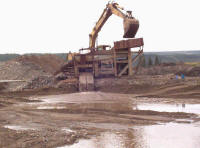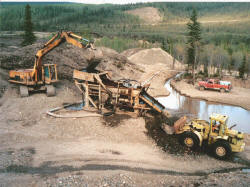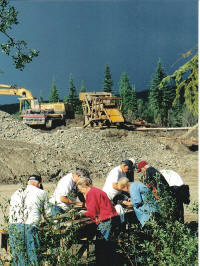|
|
Chicken Creek Mine history
Gold was first discovered in the Chicken Creek drainage in 1896, 10
years after the initial Fortymile discovery, and has been mined
continuously since then with the exception of the war years. The
Fairbanks Exploration Company, a subsidiary of the U.S. Smelting
Refining & Mining Co., acquired most of the claims during the 1940’s and
dredged 2 miles of the creek from 1959 to 1967.
Since then, several family operations have mined on the creek. The
drainage has most likely produced over 100,000 oz. of gold. The current
company began operating the Chicken Creek Mine in 1990 as lessees and
purchased ground in 1998. In 2000, they began to implement a sustainable
development plan incorporating mining, reclamation, tourism and local
history. In 2001, the efforts were recognized by the State of Alaska
when they received the prestigious Alaska Governor’s Award for Mine
Reclamation.
In 2006, they were recognized
nationally as the small mine operator of the year by the U.S. Interior
Department with the Reclamation and Sustainable Mineral Development
Award. Lately, the mining operation has taken a back seat to the rest of
the business, but they continue to operate the Chicken Creek Mine as
time permits. When they are operating, tourists are welcome to view the
operation. And when they are not, there is plenty of gold for tourists
to find, since most of the remaining ground is available for panning and
recreational mining opportunities.
The 3-cubic-foot dredge (measurement of the bucket capacity), the smallest in the F.E. Co.'s dredge fleet, mined over 55,000 ounces of gold in the eight years on Chicken Creek.
In 1998, after sitting idle for
31 years, the million pound dredge was moved in one piece to its present
location at the Chicken Gold Camp & Outpost. The dredge was opened to
the public in August 2005. It is the most complete bucket line gold
dredge open to the public in
The Grand Opening of Pedro Dredge was held in 2006; tours are now offered daily throughout the season. In June 2006, years of work were rewarded when the dredge was listed on the National Register of Historic Places.
Gold Dredges of the North
Most people believe that gold mining in the
With buckets that gouged out several cubic yards of gravel on each pass, enormous amounts of material could be processed by a dredge, so even fairly poor ground could be profitably mined.
The bucket-line dredges that changed the character of gold mining in
Preserving machinery the size of a gold dredge can present enormous technical problems. In 1996, Dredge No. 4, which is owned by Parks Canada, was found to have structural damage which required extensive emergency repairs to save the gantry structure.
Several private attempts are being made in
The use of huge dredges such as the ones in the Klondike and at
Most modern dredges are much smaller, and use suction to bring up the gold-bearing gravel from river bottoms. Many are used by "recreational" miners due to their relatively low cost and ease of use.
The largest and most famous of the dredges were manufactured by Yuba or
Marion, but many other companies built dredges of various sizes.
|
|




